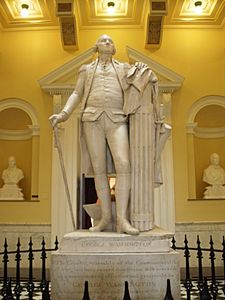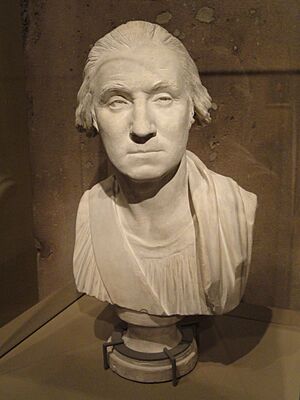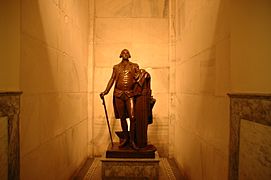George Washington (Houdon) facts for kids
Quick facts for kids George Washington |
|
|---|---|

Original sculpture by Houdon
|
|
| Artist | Jean-Antoine Houdon |
| Year | 1785–1792 |
| Medium | Carrara marble |
| Location | Virginia State Capitol, Richmond, Virginia |
| Owner | Commonwealth of Virginia |
The George Washington statue is a famous sculpture made by French artist Jean-Antoine Houdon in the late 1700s. It is thought to be one of the most accurate pictures of George Washington. This is because Houdon took a "life mask" of Washington's face. A life mask is a mold made directly from a living person's face. He also took many other measurements.
The original statue is in the Virginia State Capitol building in Richmond, Virginia. Many copies of this statue have been made over the years.
The exact dates for the statue can be a bit confusing. Virginia's government ordered it in 1784. Houdon started working on it in 1785. The statue is signed "1788," but it was finished in 1791 or 1792. It finally arrived in Virginia in 1796.
Contents
What the Statue Looks Like
The first statue is made from Carrara marble and weighs 18 tons. It shows George Washington standing up, life-sized. In his right hand, he holds a walking stick. His left arm rests on a fasces. A fasces is a bundle of rods with an axe, which was a symbol of power in ancient Rome. His cape and sword hang on the fasces. Behind him, there is a plow.
Washington is wearing his military uniform. He wanted to be shown in clothes from his own time. This was different from the popular style back then, which often showed people in old Roman or Greek clothing.
The statue includes both everyday objects (the plow and cane) and military items (the fasces, sword, and uniform). This mix of items makes people think of an ancient Roman leader named Cincinnatus. Cincinnatus was a general who gave up his power to return to his farm. George Washington was often compared to Cincinnatus because he chose to retire from public life after the American Revolutionary War.
When the statue was ordered, Washington had not yet become the first President of the United States. John Marshall, a friend of Washington's, said the statue was a "perfect image" of the living Washington.
How Houdon Made the Original Statue
In 1784, the government of Virginia decided they wanted a statue of George Washington. They wanted it to be made from the "finest marble and the best workmanship." This meant they needed a skilled artist from Europe. The Governor of Virginia asked Thomas Jefferson, who was America's representative in France, to choose the artist. Jefferson and Benjamin Franklin suggested Jean-Antoine Houdon. He was the most famous sculptor of his time.
Houdon didn't want to work only from a drawing of Washington. He also hoped to get another job making a statue of Washington on horseback. So, Houdon agreed to travel to the United States to work directly with Washington. He even asked for insurance in case he died during the trip. On July 28, 1785, Houdon sailed from England with Benjamin Franklin and two helpers. They arrived in Philadelphia, Pennsylvania, on September 14.
In early October 1785, Houdon and his assistants stayed at Washington's home, Mount Vernon. There, Houdon took detailed measurements of Washington's body. He also made a life mask of Washington's face. By December, Houdon had returned to France.
Even though the statue is marked with the date "1788," it was finished in France in 1791 or 1792. It finally arrived in Richmond in 1796. It was placed in the capitol building on May 14, 1796. There were delays in its delivery. Some reasons include the French Revolution and slow payments to Houdon. Most sources agree that the new Virginia State Capitol building was still being built, so the statue couldn't be put in place until it was ready.
The statue of Washington on horseback that Houdon hoped to make was never ordered from him. That statue was finally made in 1860 by Clark Mills.
In the early 2000s, this statue, along with Houdon's life mask and bust, helped scientists. They used them to recreate how George Washington looked at different ages. This project was done by Mount Vernon.
Copies of the Statue
Starting in the 1800s, many copies of Houdon's statue were made. These copies were often made from bronze or plaster. Molds were sometimes taken directly from the original statue.
Hubard Casts
In 1831, a different statue of Washington by Antonio Canova was destroyed when the North Carolina State House burned down. This made people worried that Houdon's statue might also be destroyed. So, in the 1850s, Virginia's government allowed 11 bronze copies to be made. Six of these bronze copies were made by a company in Richmond owned by artist William James Hubard.
Here are some places where you can find Hubard casts:
- Virginia Military Institute in Lexington, Virginia, put up in 1856.
- North Carolina State Capitol, put up in 1857. This one replaced the destroyed Canova statue.
- South Carolina State House grounds in Columbia, South Carolina, made in 1853 and put up in 1858.
- Lafayette Park in St. Louis, Missouri, placed there in 1914.
- Alumni Hall at Miami University in Oxford, Ohio.
- New York City Hall, made in 1857 and bought in 1884.
A plaster copy made by Hubard was once in the U.S. Capitol. In 1950, it moved to the Smithsonian American Art Museum. In 2007, it was given to the Jamestown-Yorktown Foundation in Virginia.
-
George Washington cast by Hubard, at the Virginia Military Institute
-
at the North Carolina State Capitol
Gorham Casts
In the early 1900s (1908 or 1909), Virginia ordered a new copy for the National Statuary Hall Collection. This copy is now in the United States Capitol rotunda in Washington, D.C.
In 1910, Virginia's government passed a law. It allowed the Gorham Company to make more copies of the Houdon statue. They could use the molds that Virginia owned. These copies could be sold to governments, universities, schools, libraries, and patriotic groups. Each copy had to have Virginia's state seal and the words, "Copied from the original by Houdon..." Gorham had to pay Virginia $500 for each statue they made. The law also said no new molds could be taken from the original statue in the future. So, all later copies were made from the existing molds.
-
In the Valley Forge National Park
-
Inside the Washington Monument
Here are some places where you can find Gorham casts:
- In 1910, Virginia gave a bronze copy to the people of France.
- Springfield, Massachusetts.
- Jefferson Memorial Park, Pittsburgh, Pennsylvania, 1910.
- Oshkosh, Wisconsin, 1911.
- University of Virginia, Charlottesville, Virginia, put up in 1913.
- The Art Institute of Chicago, 1917. This statue was moved inside the museum in 1979. It is now in the Chicago City Hall.
- The National Gallery in London, 1921.
- Lima, Peru, put up on July 4, 1922.
- Philadelphia, Pennsylvania, 1922. This statue was first at the Philadelphia Museum of Art. It moved to Washington Square in 1954.
- National Heritage Museum, Lexington, Massachusetts; made in 1924.
More copies were made for the 200th birthday of Washington. You can find them in:
- Fair Oaks Park, Minneapolis, Minnesota, given in 1931 and put up in 1932. This statue was knocked down in November 2020.
- Valley Forge National Historical Park, Valley Forge, Pennsylvania.
- Civic Center Plaza, Los Angeles, California; made and given in 1933.
- City College of New York, 1931.
- Redwood Library and Athenaeum, Newport, Rhode Island. Put up in 1932.
- Albany, New York, put up in 1932.
- The quad at George Washington University, 1932.
- Maxwell School foyer at Syracuse University, 1937.
Other Casts
A few more copies have been made since the Gorham castings:
- John M. Olin Library at Washington University in St. Louis, St. Louis, MO, made in 2004.
- Larz Anderson House, headquarters of the Society of the Cincinnati, Washington, D.C., made in 2008.
Many plaster copies were also made. One from 1932 is in the Indiana Statehouse in Indianapolis, Indiana. Another is in George Washington Hall at the University of Mary Washington in Fredericksburg, Virginia. It was made in the 1930s.
See also
 In Spanish: Estatua de George Washington (Houdon) para niños
In Spanish: Estatua de George Washington (Houdon) para niños







